
- R. Couri Hay
- 0
WHITE NIGHTS
Come to St. Petersburg for the White Nights in June and July, when the region boasts up to 21 hours of daylight. Delight in the wonders of this city that’s often compared to Venice and Paris because of its rivers and canals. But don’t be afraid to come in the fall or winter. On a recent visit in early spring, I watched a light snowfall silently over the tulips just beginning to peek out in the Hermitage gardens and dust the endless architectural treasures of this great and grand city. With so much to see and do in every season, this magical place calls for repeat visits, and those who love ballet, opera, and fine arts would do well to make it a regular destination.
FLIGHT
No direct flights connect New York to this city that has also been named Petrograd and Leningrad and then, in 1991, after the collapse of the Soviet Union, reverted to its original name. St. Petersburg was so named by Tsar Peter the Great, after his patron saint, who is traditionally pictured holding the keys to heaven. I wanted to get here quickly (12 hours, lol) so I flew through Warsaw, Poland, on a night flight that leaves JFK in the evening and arrives a day later, in time for dinner at the Four Seasons. I booked a perfect flatbed on Lot Airlines, where the service was friendly and the food tasty. Always ask for a single window seat for maximum privacy. After I landed, I was greeted by a lovely woman holding a golden tablet that signals the luxurious hospitality that is the Four Seasons Hotel. I was whisked to one of its newest palaces in a BMW 7 Series sedan.
THE LION PALACE, A FOUR SEASONS HOTEL
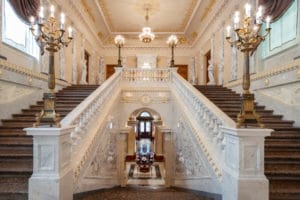
In 2013, after a six-year, multi-million-dollar renovation, the Four Seasons opened its heavenly hotel in the former palace of Prince Alexander Yakovlevich Lobanov-Rostovsky. This was the uber brand’s first property in Russia. Known as the Lion Palace, thanks to the imposing pair of marble lions flanking the entrance, the triangular, pale yellow, circa 1820 building is one of St. Petersburg’s iconic landmarks. Located in the heart of the city, at the intersection of Admiralteysky Prospekt and Voznesensky Prospekt, the Four Seasons is a short walk from other top sights, including the State Hermitage Museum and Palace Square. If you can’t look out your window and see a landmark immediately identified with the city you’re in, I believe you are in the wrong room or the wrong hotel. Luckily at this Four Seasons, you can’t go wrong. I woke up a little woozy from the flight to find two angels with enormous white wings perched outside my windows in front of a golden-domed cathedral. I thought I was hallucinating until I stepped onto my terrace and realized, of course, they were made of white marble. Next to the hotel is the magnificent St. Isaac’s Cathedral, one of the city’s most important landmarks. To see snowflakes brush St. Isaac’s golden dome that soars nearly a hundred feet into the sky is as close to heaven as many people will ever get.
SAINT ISAAC’S CATHEDRAL
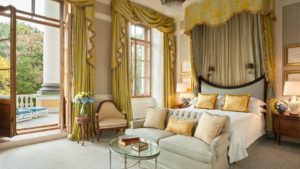
But no worries if you’re not a believer. Saint Isaac’s was turned into a museum by the Soviet government in 1931 and is a must-see attraction. Completed in 1858 by order of Tsar Alexander I, the cathedral was designed by Auguste de Montfort-rand and still dominates the city’s skyline. Built to accommodate 14,000 worshippers, the soaring space features detailed mosaics and paintings, columns of malachite and lapis lazuli, and magnificent stained-glass windows.
TREATS AT THE FOUR SEASONS
At the Four Seasons, a different surprise arrives at your door every day, an unexpected treat for the guests. The first day I found a basket masterfully woven of chocolate with gold leaf edges that were filled with the most delicious chocolate truffles. Another day, a glass dome covered a tray of caviar-filled hors d’oeuvres, and my favorite was a blue Easter egg with city landmarks etched in gold. Because it’s Russia where every egg needs to contain a surprise, inside the egg, were hidden two scrumptious chocolate truffles. There are never enough tins of caviar or truffles n’estce pas?
THE HERMITAGE
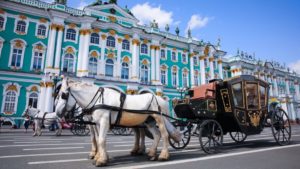
The Hermitage is one of the greatest art museums in the world. It houses over three million priceless objects, which would take you more than ten years to see even if you spent only one minute on each piece of art — and that’s not taking into account the breathtaking gold leafed interiors and frescoes of Imperial-era Russia. Five of the buildings in the Hermitage complex are open to the public. It includes the Winter Palace, which Peter the Great established as his winter residence. Over nearly 200 years, Tsars and Tsarinas lived in, reinvented, and expanded the Winter Palace, until the Russian Revolution in 1917. Catherine the Great, who ruled from 1762 to 1795, added what is now known as the Small Hermitage to house her immense art collection. She patronized Russian and European painters, and she collected thousands of carved gems, especially cameos. Her collection eventually outgrew the space, so she added several extensions to the palace to house it. When it was the home of the royal family, court cats had free reign. Catherine the Great famously said: “There are few visitors to the galleries—only me and the mice.” Just some highlights of the Hermitage’s 17,000 paintings include works by Leonardo, Rafael, Titian, El Greco, Rembrandt, Rubens, and other Old Masters.
PALACE SQUARE, IMPRESSIONIST AND POST-IMPRESSIONIST PAINTINGS
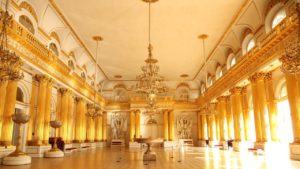 Across Palace Square, at the General Staff Building, you’ll find some of the world’s most important paintings. At one time hidden away in the Hermitage attic, masterpieces like Matisse’s The Dance and Music, works from Picasso’s Blue and Red Periods, and paintings by Renoir, Manet, Monet, Kandinsky, among others, are now beautifully displayed in their own spacious venue. Some contemporary works are on display, but with so much else to see, your time would be better spent taking in other parts of this stellar collection. Tip: Ask the concierge at the Four Seasons to book the special 9 a.m. tickets and beat the crowds that usually arrive by noon. The museum officially opens at 10:30 a.m. It is definitely worth purchasing the separate tickets required to view the Gold and Diamond rooms containing treasures made of gold and diamonds.
Across Palace Square, at the General Staff Building, you’ll find some of the world’s most important paintings. At one time hidden away in the Hermitage attic, masterpieces like Matisse’s The Dance and Music, works from Picasso’s Blue and Red Periods, and paintings by Renoir, Manet, Monet, Kandinsky, among others, are now beautifully displayed in their own spacious venue. Some contemporary works are on display, but with so much else to see, your time would be better spent taking in other parts of this stellar collection. Tip: Ask the concierge at the Four Seasons to book the special 9 a.m. tickets and beat the crowds that usually arrive by noon. The museum officially opens at 10:30 a.m. It is definitely worth purchasing the separate tickets required to view the Gold and Diamond rooms containing treasures made of gold and diamonds.
THE MARIINSKY THEATRES
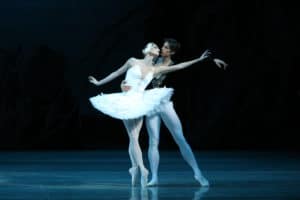
Highlights of the Mariinsky this season included the world premiere of Porte Rouge, the ballet choreographed by ABT ballerina Melanie Hamrick to music by The Rolling Stones, edited by Mick Jagger, her partner. The piece was originally commissioned by Larissa Saveliev, the director of Youth America Grand Prix, for the Spring Gala at Lincoln Center this year. The circa 1860 Mariinsky Theatre and its 2007 cousin, the Mariinsky II — a theater and concert hall — offer almost non-stop ballet, opera, and musical performances. Rimsky-Korsakov’s The Tsar’s Bride, a compelling opera about love, betrayal, and revenge, and the classical ballet Giselle, with a brilliant cast including Oxana Skorik as Giselle and Kimin Kim as Count Albrecht, were among the shows playing during my visit.
THE RUSSIAN MUSEUM
The State Russian Museum is the world’s largest depository of Russian fine art, and, like many of the popular attractions in St. Petersburg, it’s housed in an extravagant palace. Make that three palaces: the main collection is at Mikhailovskiy Palace, while the Marble Palace, acquired in 1992, houses contemporary art, and the Stroganov Palace, which contains 18th- and 19th-century works that were once owned by prominent families. Tsar Alexander III amassed a collection by Russian artists, and in 1895 his son Nicholas II, purchased the Mikhailovskiy Palace to house it. The confiscation of private collections after the revolution of 1917 proved to be a huge boon to the museum. Today it includes over 400,000 artworks covering Russian art from the 10th to the 21st centuries.
FABERGÉ MUSEUM
Billionaire industrialist Viktor Vekselberg had dreamt of returning national artistic treasures to Russia, and in 2004 he purchased 200 Fabergé objects owned by the American Forbes family for reportedly more than $100 million. He then took over the 19th-century canal-front Shuvalov Palace and restored its grandeur with elegant silk wall coverings, sparkling chandeliers, and gilded plasterwork as a setting worthy of this collection.
ROYAL EGGS
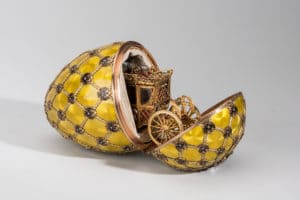
There are 14 of the 50 Royal Eggs here, including the very first, the “Hen,” created by Peter Carl Fabergé’s workshop in 1885 as an Easter gift for Emperor Alexander III’s wife. That first egg is deceptively plain, in cream-colored enamel over solid gold, because the Tsar directed Fabergé to make it realistic looking. The egg opens to reveal a gold yolk, which opens to reveal a hen with ruby eyes. A replica of the Imperial crown and a ruby pendant were the final surprises within the hen, but these went missing. Other eggs on display are fabulously elaborate works encrusted with gems. With over 1,000 Fabergé pieces, this is the world’s largest private collection, and the museum also contains 3,000 other pre-Soviet era Russian artworks.
FRIDA KAHLO & DIEGO RIVERA
The museum also hosts important traveling shows, and this spring they had an in-depth exhibition of works by Frida Khalo and her husband, the painter Diego Rivera, beautifully mounted in the palace ballroom that normally shows work by major Russian artists. This show is traveling around the world and if you’re lucky enough to be in place when it is on exhibit, don’t miss it. It’s at the Frist Museum in Nashville, Tennessee, from May 25 through September 2, 2019.
CHURCH OF THE SPILT BLOOD
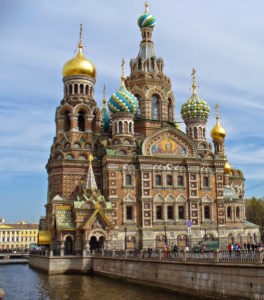
There are a lot of gorgeous churches in this city and although some still serve as centers of worship, most have been turned into museums. My favorite is commonly called the Church of the Spilt Blood, more formally known as the Church of the Savior on Spilled Blood, and the name is due to the fact that it is built on the exact spot where Alexander II was assassinated with a bomb in 1881. His son, Alexander III, ordered the cathedral built, and the Griboedov Canal along which it stands was narrowed to allow the church to encompass the cobblestone road on which the tsar was attacked. The church is one of the most popular sights in St. Petersburg, in large part because of its striking, colorful architecture; it is so lavish, it took 24 years to complete. The interior is breathtaking as well, with over 23,000 feet of mosaic artwork, even inside the main dome. The church was heavily damaged during the Russian Revolution of 1917, and again during World War II, and was later used for storage. Eventually, St. Isaac’s Cathedral took over management of the building, undertaking a 25-year restoration which returned it to its former glory. Even in this staggeringly beautiful city, the Church of the Spilt Blood is considered a rare jewel.
YUSUPOV PALACE
One of the only imperial-era residences in St. Petersburg that retains much of its original interiors and furniture is the Yusupov Palace, home of the ultra-wealthy Yusupov family. What makes it famous isn’t its private theatre or rococo ballrooms that could hold parties for 2,000 people, but the fact that Rasputin, the magician, healer, or fraud that had the ear of Tsar Nicholas II, was murdered here in the basement apartment. Prince Felix Yusupov and his cohorts plied Rasputin with drugged wine, and then shot him, only to have him escape through a small door to the courtyard, where he was finished off and thrown into the Neva River. This is the stuff they write books about and make Hollywood movies of. There are tours of the chambers where Rasputin’s murder took place.
THE NAVAL CATHEDRAL OF SAINT NICHOLAS
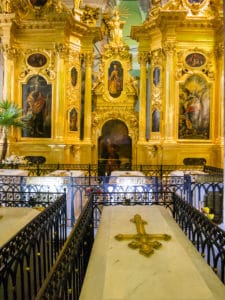 A pale blue Russian Orthodox church known as the Naval Cathedral is where sailors prayed before heading out to sea, and inside are stunning stained-glass windows, and memorial plaques bearing the names of Russian naval officers and sailors who have fallen in battle.
A pale blue Russian Orthodox church known as the Naval Cathedral is where sailors prayed before heading out to sea, and inside are stunning stained-glass windows, and memorial plaques bearing the names of Russian naval officers and sailors who have fallen in battle.
PETER & PAUL FORTRESS
The main attraction on the island fortress of Kronstadt is the ornate church that boasts one of the most elaborate baroque altars in the world. This fortress was the first structure built in St. Petersburg in 1703. It was never used for defense purposes but has had a colorful history, most prominently its cathedral, which is the burial place of nearly all of the Russian royal family since Peter the Great. The graves of the Romanov rulers including Peter the Great, Catherine the Great, and Nicholas II and his family. The murdered Russian princess Anastasia is buried here despite the oft-repeated claims that she had escaped and was alive and well and living, well, almost everywhere. The fortress is also a popular gathering place for St. Petersburg locals, where walruses sunbathe on the beach and frolic in the water in all seasons. In warmer months, locals picnic and attend concerts and festivals here.
Go to St. Petersburg, You will treasure the experience.

